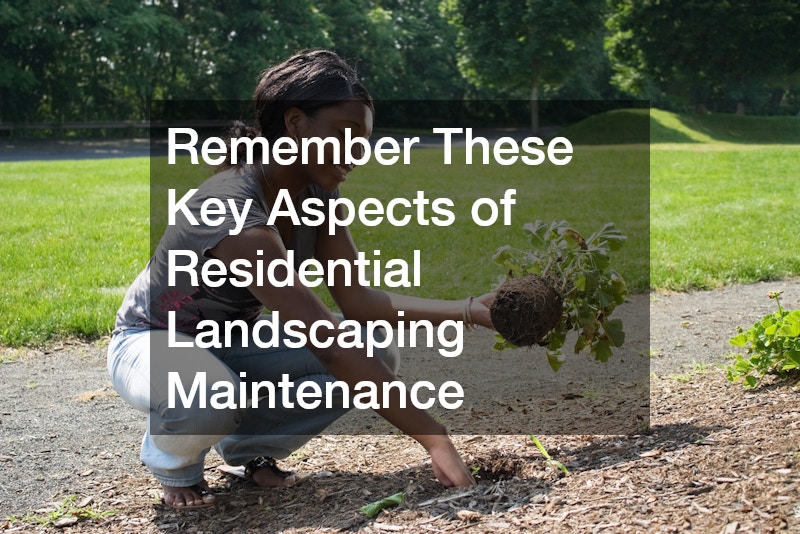A home’s exterior is often a direct reflection of the homeowner’s personality and values. Everything from the color of the front door to the variety of greenery in the yard adds up to create an inviting atmosphere. But a beautiful outdoor space doesn’t happen by accident—it demands consistent attention and thoughtful planning. Many people envision lush lawns, thriving flower beds, and well-groomed trees, yet they may underestimate the time and effort required to sustain that vision. This is where residential landscaping maintenance comes into play. It’s the comprehensive approach to preserving both the functionality and aesthetics of a home’s surroundings.
Effective yard care involves more than mowing the grass or occasionally pruning shrubs. It includes making strategic choices about soil health, planting schemes, water usage, weed control, and even tree management. Each of these elements works in tandem to ensure that your outdoor space remains vibrant and resilient through changing seasons. Engaging in residential landscaping maintenance goes beyond boosting curb appeal; it also supports biodiversity, aids in environmental conservation, and can even enhance property value. In the following sections, we’ll delve into core principles, from nurturing the soil that anchors your plants to bringing in specialized services for complex tasks like tree removal or large-scale design changes. Whether you prefer a hands-on approach or like to collaborate with experts, understanding these fundamentals will help you create an outdoor haven you can be proud of all year long.
Focus on Soil Health and Preparation
Healthy soil is the cornerstone of any flourishing garden, lawn, or landscaped space. Whether you’re growing vegetables, cultivating a rose garden, or simply maintaining the grass, the earth beneath your feet is where the magic begins. A key part of residential landscaping maintenance is making sure the soil has the right balance of nutrients, organic matter, and proper drainage. Testing the soil to determine its pH level and nutrient content can be an enlightening first step, as this helps you pinpoint deficiencies and address them efficiently.
In many cases, incorporating compost, well-rotted manure, or leaf mold improves the soil’s structure and fertility. These organic materials support essential microbes that break down nutrients so plants can absorb them. Adequate aeration is also vital; compacted soil can hinder root growth and water penetration. If necessary, aerate using a core aerator to allow more oxygen and water to reach deeper layers, ensuring robust root development. When the foundation of your garden is set up for success, all other aspects of maintenance—from weed control to watering—become more manageable. Healthy soil not only makes plants more resilient but also reduces the need for excessive fertilization or pesticides, contributing to a more sustainable landscaping approach overall.
Select Plants and Shrubs Wisely
Another vital consideration in residential landscaping maintenance is choosing vegetation that aligns with the local climate, soil conditions, and light availability. While it’s tempting to pick plants solely for their visual appeal, factors like hardiness zones, rainfall patterns, and sun exposure are equally important. Native or climate-adapted species often thrive more easily and resist common pests better than exotic alternatives. By selecting plants that can withstand your local environment, you minimize the need for constant watering, fertilizing, or chemical interventions.
Microclimates also play a role in effective plant selection. Even within a single property, certain areas might be cooler or more shaded, while others are exposed to full sun or experience stronger winds. Placing a moisture-loving plant in a dry, sunny section of the yard will likely lead to constant stress for the plant and extra work for you. Conversely, a plant that requires good drainage might succumb to root rot if placed in a boggy spot. Thoughtful placement boosts plant longevity and overall health, which means fewer replacements and less money spent in the long run. When in doubt, consult local nurseries or horticultural experts who can provide tailored recommendations for what will flourish in your particular setting.
Water with Precision
Overwatering or underwatering can sabotage even the most carefully planned landscape. Striking the right balance is a pivotal part of residential landscaping maintenance because hydration directly affects plant health, soil quality, and susceptibility to pests. Installing a drip irrigation system or soaker hoses for flower beds and shrubs can be especially beneficial. These methods deliver water directly to the root zone, reducing evaporation and helping to keep leaves dry, which lowers the risk of fungal infections.
Timing also matters. Early morning watering allows moisture to seep into the soil before the heat of the day accelerates evaporation. Watering late at night can lead to prolonged leaf dampness, a breeding ground for mildew and other diseases. Smart irrigation controllers and rain sensors help automate this process, adjusting water output based on weather conditions and soil moisture levels. This kind of efficiency not only conserves water but also lowers utility bills. By tailoring your watering habits to your region’s climate and individual plant needs, you ensure that every drop counts and your plants remain vibrant and resilient.
Use Mulch and Control Weeds
Weeds can quickly spoil a pristine yard, robbing desired plants of nutrients and water. An often-underestimated technique to combat this issue is mulching, which is an essential element of residential landscaping maintenance. Mulch forms a protective layer over the soil, locking in moisture, regulating temperature, and restricting sunlight that might otherwise encourage weed growth. Organic mulches such as shredded leaves, bark chips, or straw can also enrich the soil as they decompose, boosting its fertility over time.
Before applying mulch, clear the area of existing weeds, either through hand-pulling, hoeing, or targeted herbicides where necessary. Apply a two- to three-inch layer of mulch around plants, making sure to keep it slightly away from stems or trunks to prevent rot and pest problems. Regularly check the mulch thickness throughout the growing season, topping it off if it becomes thin. If weeds do pop through, remove them promptly so they don’t release seeds. Staying on top of weed control saves you a lot of headache in the future and keeps your ornamental beds and lawn looking immaculate.
Give Trees the Attention They Deserve
Trees are focal points in many landscapes, offering shade, aesthetics, and often a boost to property value. However, they’re also living organisms that require specialized care. A strong component of residential landscaping maintenance is monitoring tree health for signs of disease, pest infestation, or structural instability. Hiring a local tree service to perform inspections and routine checkups can save you from bigger headaches later on, such as falling branches or widespread disease.
Pruning is crucial not just for tidiness but for the longevity of the tree. A quality tree trimming service can shape the canopy, remove dead or weak branches, and enhance airflow among the branches. If a tree becomes severely diseased or hazardous, you may need to consult tree removal contractors for guidance on whether it can be saved. In cases where removal is the only option, a local tree removal service can handle the process safely and efficiently, adhering to municipal regulations. It’s wise to choose an affordable tree service that still has the necessary credentials and experience; this ensures you get professional advice without overspending. Proactive tree management not only maintains the beauty of your yard but also protects your home and family from potential hazards.
Maintain a Healthy Lawn
For many homeowners, a lush lawn serves as the centerpiece of their outdoor space. Keeping grass healthy involves regular mowing, aeration, fertilization, and weed control. Residential landscaping maintenance also means knowing the right type of turf for your region. Cool-season grasses flourish in milder climates, whereas warm-season grasses excel in hotter areas. By selecting the correct variety, you reduce the need for excessive watering and chemical fertilizers.
If you have little time for lawn care, consider relying on lawn services for tasks such as mowing, edging, and seasonal treatments. These professionals have a keen eye for early signs of disease or nutrient deficiencies and can recommend treatments before issues escalate. Another alternative for those seeking minimal upkeep is to install artificial turfs in high-traffic zones or areas prone to water shortages. While synthetic grass doesn’t suit every situation, it can be a solution for homeowners looking to cut down on watering, mowing, and fertilizing. If you prefer natural grass but seek expert assistance in establishment or renovation, contact turf services to help you pick the best seed blends, manage soil conditions, and create a lawn that remains vibrant under local weather conditions.
Look After Hardscapes
Hardscapes—like patios, walkways, driveways, and retaining walls—are integral to a well-rounded landscape. Yet, they often get overlooked in discussions about residential landscaping maintenance. Regular cleaning and inspections go a long way in preventing staining, weed growth in cracks, and the breakdown of materials due to weathering. Power washing can remove algae, mold, and dirt, but be mindful of the pressure settings to avoid damaging delicate surfaces like natural stone or older concrete.
Small repairs, such as re-grouting pavers or filling cracks in concrete, should be tackled as soon as they’re noticed. Neglect can lead to more extensive damage that requires expensive restoration later. Also, keep drainage in mind around hardscapes. Pooling water can weaken foundations, undermine walls, or create slippery surfaces. Enhancing the drainage system—whether by installing French drains or simply grading slopes away from your home—helps maintain structural integrity. Hardscapes form the backbone of outdoor living areas, so taking the time to preserve them will ensure they continue to provide both function and style.
Be Prepared for Seasonal Changes
Each season brings different challenges and opportunities for anyone committed to residential landscaping maintenance. In spring, you’ll likely deal with cleaning up debris left from winter storms, preparing flower beds, and fertilizing the lawn. This is often the optimal time to perform tasks like dividing perennials, planting new shrubs, and refreshing mulch to give your yard a bright start.
Summer maintenance can be intense, particularly with weed growth and irrigation demands. Regularly inspect your watering system to ensure it’s functioning correctly. Keep a close watch on pest pressures and plant diseases, as warmer temperatures can accelerate their spread. Moving into fall, focus on leaf removal and pruning tasks. This helps the lawn ‘breathe’ and preps trees and shrubs for dormancy. In some cases, pruning is best done when deciduous trees have lost their leaves, allowing for a clear view of the branch structure. Winter might offer a lull in outdoor chores, but it’s an excellent time to protect vulnerable plants, clean and sharpen tools, and plan any major landscape overhauls for the upcoming year. By anticipating the needs of each season, you ensure your yard maintains its beauty and health throughout the calendar.
Embrace Long-Term Sustainability
Sustainability is becoming increasingly important for homeowners who want their landscapes to be both eco-friendly and budget-conscious. Residential landscaping maintenance anchored in sustainable methods can minimize resource consumption and chemical inputs. One straightforward approach is to utilize rain barrels or other water-harvesting methods. This captured rainwater can be used for irrigation during drier months, effectively reducing dependence on municipal water sources.
Composting is another eco-conscious practice. Garden debris, kitchen scraps, and other organic material can be composted and then returned to the soil, enriching it with nutrients. This closed-loop system reduces waste while boosting soil health, which in turn supports healthier plants. Additionally, seeking alternatives to chemical pesticides and synthetic fertilizers—such as using integrated pest management or planting beneficial companion species—further promotes a balanced ecosystem. Whenever possible, opt for materials that have a reduced environmental footprint, like permeable paving for walkways, to allow rainwater to return to the ground. Over time, adopting these measures can yield a robust landscape that flourishes with minimal intervention, benefiting both the environment and your wallet.
Know When to Hire Professionals
While many homeowners enjoy taking a do-it-yourself approach, certain tasks are best left to experts. For instance, large-scale tree removals, complex irrigation overhauls, and major hardscape installations require specialized knowledge, equipment, and safety measures. Attempting these on your own can lead to costly mistakes or even personal injury. When trees become hazardous or diseased, a tree removal contractor can assess whether to prune, treat, or remove them. Professional local tree services not only handle dangerous tasks but also navigate local regulations and permit requirements.
For broader landscaping redesigns or trouble spots like severe drainage issues, consider consulting landscape architects or designers. They can craft a cohesive plan that integrates plantings, hardscapes, and drainage solutions into a unified and appealing layout. If you’re grappling with frequent lawn problems or planning to install new turf, turf services can provide expert guidance on soil preparation and grass variety selection. Similarly, if you require ongoing assistance, look into a partnership with local tree service providers or lawn services, ensuring specialized care is just a phone call away. Balancing do-it-yourself spirit with professional expertise allows you to maintain a harmonious, well-tended landscape without the pitfalls that can come from inexperience.
Implementing these practices doesn’t have to be overwhelming. Start by focusing on the essentials: good soil, mindful plant choices, and efficient watering. Gradually introduce more advanced strategies like composting, seasonal cleanups, and pest management tailored to your specific region. When in doubt, remember that professional help—whether from tree removal contractors, lawn services, or other specialists—is readily available.






